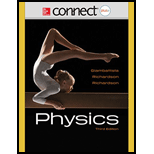
Concept explainers
(a)
The position of the final image.
(a)
Answer to Problem 81P
The position of the final image is
Explanation of Solution
Write lens equation for converging lens.
Here,
Rearrange above equation to get
The image produced by the converging lens acts as object for the diverging lens.
Write the expression for diverging lens.
Here,
Write lens equation for diverging lens to get
Here,
Conclusion:
Given that focal length of converging lens is
Substitute
Substitute
The negative sign for
Substitute
Since both the lenses are separated by
Therefore, the final image is formed at
(b)
The height of the final image.
(b)
Answer to Problem 81P
The height of the final image is
Explanation of Solution
Write the expression for the magnification of image.
Here,
Analogues to above equation, write magnification of the image formed by converging and diverging lens.
Here,
Write the expression for the total magnification.
Substitute (IV) and (V) in above equation.
Write magnification equation in terms of height of object and image.
Here,
Equate Equations (VI) and (VII) to get
Conclusion:
Substitute
Therefore, the height of the final image is
(c)
Whether the image is upright or inverted.
(c)
Answer to Problem 81P
The image is upright, since transverse magnification is positive.
Explanation of Solution
According to sign convention heights above principle axis are positive whereas heights below principle axis are negative.
In the question, since object is real upright
Conclusion:
It is found that transverse magnification of the image is positive. This clearly indicates that the image is upright.
The image is upright, since transverse magnification is positive.
Want to see more full solutions like this?
Chapter 24 Solutions
Physics - Connect Access (2 Semester)
 College PhysicsPhysicsISBN:9781305952300Author:Raymond A. Serway, Chris VuillePublisher:Cengage Learning
College PhysicsPhysicsISBN:9781305952300Author:Raymond A. Serway, Chris VuillePublisher:Cengage Learning University Physics (14th Edition)PhysicsISBN:9780133969290Author:Hugh D. Young, Roger A. FreedmanPublisher:PEARSON
University Physics (14th Edition)PhysicsISBN:9780133969290Author:Hugh D. Young, Roger A. FreedmanPublisher:PEARSON Introduction To Quantum MechanicsPhysicsISBN:9781107189638Author:Griffiths, David J., Schroeter, Darrell F.Publisher:Cambridge University Press
Introduction To Quantum MechanicsPhysicsISBN:9781107189638Author:Griffiths, David J., Schroeter, Darrell F.Publisher:Cambridge University Press Physics for Scientists and EngineersPhysicsISBN:9781337553278Author:Raymond A. Serway, John W. JewettPublisher:Cengage Learning
Physics for Scientists and EngineersPhysicsISBN:9781337553278Author:Raymond A. Serway, John W. JewettPublisher:Cengage Learning Lecture- Tutorials for Introductory AstronomyPhysicsISBN:9780321820464Author:Edward E. Prather, Tim P. Slater, Jeff P. Adams, Gina BrissendenPublisher:Addison-Wesley
Lecture- Tutorials for Introductory AstronomyPhysicsISBN:9780321820464Author:Edward E. Prather, Tim P. Slater, Jeff P. Adams, Gina BrissendenPublisher:Addison-Wesley College Physics: A Strategic Approach (4th Editio...PhysicsISBN:9780134609034Author:Randall D. Knight (Professor Emeritus), Brian Jones, Stuart FieldPublisher:PEARSON
College Physics: A Strategic Approach (4th Editio...PhysicsISBN:9780134609034Author:Randall D. Knight (Professor Emeritus), Brian Jones, Stuart FieldPublisher:PEARSON





